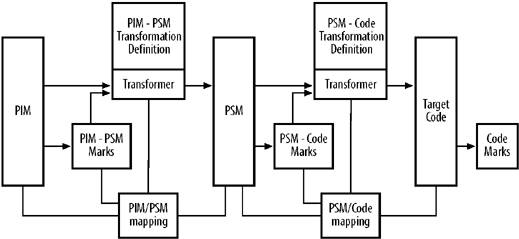Section A.5. Transforming Models
A.5. Transforming ModelsThe models up to now provide multiple abstractions of the system. They separate the platform concerns. They trace the origin of each element. These models are static. Transformation functions apply a transformation to a source model to produce a target model. Figure A-4 shows the general case of the transformation function creating or updating target models from the source model and marks. The transformation function, along with the marks and the mappings, are called the bridge between the two principle models. The mapping model acts in two roles. Before the transformation, it relates the elements of the source models, together with previous versions of the target models. After the transformation, the mapping model traces the source of every target model element created or updated. During model evolution, transformations at the PIM can cause turmoil in the PSM and code models. Because of the leverage MDA gives, slight refactoring can render the mapping model incapable of reconciling changes. If mappings are recorded by element ID, deleting an element and recreating it risks orphaning it from its marks Figure A-4. Custom model transformations automate changing abstraction levels and derivative elements in the target models. If the PSM or code model has a great deal of elaboration, MDA doesn't proscribe a solution to this. Figure A-4 shows a transformer acting through a transformation definition. The transformer can be implemented equally well as a script or a procedural language. In any case, each transformation requires its own definition; the transformer from PIM to presentation PSM can't be reused for the database PSM to SQL code model. The concept of reverse engineering, or round-trip engineering, received a great deal of interest a few years ago. MDA doesn't address it specifically. Each transformation function can have an inverse function to create the abstract from the concrete, but nothing requires an MDA solution to provide it. Reverse engineering generally creates more problems than it solves. You reverse-engineer only elaborate concrete models. Concrete models may not respect the naming conventions, or they may have slight or gross variants of expected patterns. The resultant abstract model will have no insight into the structures found. Furthermore, it becomes unclear where ultimate truth lies. Remember, MDA doesn't stand for program-driven modeling. |
EAN: 2147483647
Pages: 132